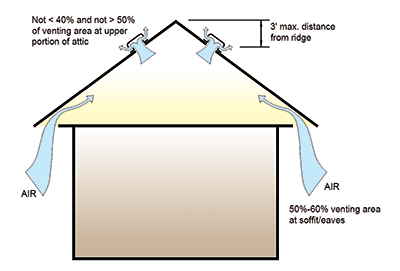Unvented attics are also said to perform better in areas where high wind events and storms are common.
Vented vs non vented attic.
A properly functioning un vented roof.
Foam and the roof assembly foam insulation can play an important role in both vented and un vented roof assemblies.
Choosing a conditioned attic vs unconditioned attic space comes down to what you want to do with the area and what works best with the design of your home.
In warmer climates unvented attics can prevent the condensation that occurs on ductwork in some vented attic spaces.
If you must have the hvac equipment in a vented attic pay special attention to duct insulation chapter 9.
Basically the term cold roof refers to a traditional roof or vented roof while hot roof refers to a roof that is not ventilated and which has foam insulation attached directly to the roof sheathing.
Codes for unvented attics.
The attic space becomes indirectly conditioned as a result of the air leakage heat transfer and vapor diffusion through the ceiling.
In high wind regions particularly in coastal areas wind driven.
However they work best with airtight ceiling attic interfaces and where ductwork and air handlers are not located within attic spaces.
An insulation contractor advises me to eliminate the planned roof soffit vents and seal the attic with foam.
Vented attic roof designs have the advantage of a long proven historical track record.
Joseph lstiburek from building science corporation.
A sealed non vented airtight attic.
The air enters the space and with the aid of attic baffles a tubular object attached directly to the underside of the roof decking but above the insulation air is free to enter and flow upwards.
When determining how to insulate this attic space various assemblies were taken into consideration and a hybrid combination of vented and unvented attic space was planned.
The dormers and the attic space over the outside porch were sealed off from the rest of the attic by making a wall of plywood then insulating the wall with closed cell spf.
Unvented roofs which provides a detailed explanation of each.
A fundamental requirement of an unvented attic assembly is the use of air impermeable insulation on the underside of the unvented roof to prevent air infiltration and exclude airborne moisture from the attic.
In an un vented roof foam can serve as the air barrier and vapor retarder and prevent moisture from getting in to the roof cavities.
The increase in the use of complex roof shapes and cathedral ceilings has resulted in problems with vented roofs.
If you want the extra storage and don t want to take the risk of moisture buildup the unvented system is the best fit for your home.
Sealed attic vs vented attic.
Non vented soffits are the same panels but they are missing the holes or screens that are found often in plywood soffit that allow air into the roof.
Requirements for unvented attic assemblies are provided in section 0806 4 of the international residential code 2009 irc.

